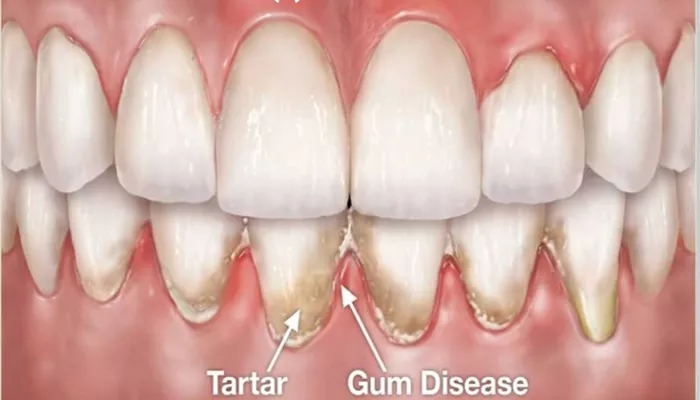Periodontal gum disease, commonly referred to as gum disease, is a serious infection that damages the soft tissue and, if left untreated, can destroy the bone that supports your teeth. It is primarily caused by poor oral hygiene that encourages plaque—a sticky film of bacteria—to form on teeth, leading to inflammation of the surrounding gum tissue. The two main types of gum disease are gingivitis, which is mild and reversible, and periodontitis, which is more severe and can lead to tooth loss.
Causes And Risk Factors
The primary cause of periodontal disease is the accumulation of plaque on the teeth. Factors that can increase the risk of developing gum disease include:
Poor Oral Hygiene: Inadequate brushing and flossing allow plaque to harden into tartar.
Smoking: Tobacco use impairs blood flow to the gums, hindering healing.
Genetics: Some individuals are genetically predisposed to gum disease.
Hormonal Changes: Fluctuations in hormones, such as during pregnancy or menopause, can make gums more sensitive.
Certain Health Conditions: Diseases like diabetes can increase susceptibility to infections, including gum disease.
Symptoms of Periodontal Disease
Recognizing the symptoms early can significantly improve treatment outcomes. Common signs include:
- Red, swollen gums
- Gums that bleed during brushing or flossing
- Persistent bad breath
- Loose teeth
- Receding gums
Diagnosis of Periodontal Disease
Diagnosing periodontal disease typically involves a thorough examination by a dentist or periodontist. This may include:
Visual Examination: Checking for swollen or bleeding gums.
Periodontal Probing: Measuring the depth of gum pockets around each tooth.
X-rays: To assess the extent of bone loss around teeth.
Importance of Early Diagnosis
Early diagnosis is crucial as it allows for more effective treatment options and can prevent further complications. If gingivitis is detected early, it can often be reversed with improved oral hygiene practices.
Treatment Options for Periodontal Gum Disease
The treatment for periodontal disease varies based on its severity. It generally falls into two categories: nonsurgical treatments and surgical interventions.
Nonsurgical Treatments
Scaling and Root Planing (SRP):
This deep-cleaning procedure involves removing plaque and tartar from below the gum line (scaling) and smoothing out rough spots on the tooth roots (planing) to prevent bacteria from reattaching.
SRP is often performed over multiple visits using local anesthesia.
Antibiotics:
Antibiotics may be prescribed to help control bacterial infection. They can be taken orally or applied directly to the gums.
Common antibiotics include tetracycline, amoxicillin, and metronidazole.
Laser Therapy:
Laser treatments are increasingly used to remove diseased tissue and promote healing without the need for incisions.
This minimally invasive procedure targets infected areas while preserving healthy tissue.
Surgical Treatments
For more advanced cases of periodontal disease, surgical options may be necessary:
Pocket Reduction Surgery:
This procedure involves lifting back the gums to remove tartar deposits and reduce the size of gum pockets.
It helps in reattaching healthy gums to teeth.
Bone Grafting:
In cases where bone has been lost due to periodontal disease, bone grafts may be used to regenerate lost bone tissue.
This provides a stable foundation for teeth.
Guided Tissue Regeneration:
This technique uses a special membrane to direct the growth of new bone and gum tissue at sites where they have been destroyed by periodontal disease.
Home Care Strategies for Prevention
Preventing periodontal disease involves maintaining good oral hygiene habits at home:
Brushing Techniques:
Brush your teeth at least twice a day using fluoride toothpaste.
Use a soft-bristled toothbrush and replace it every three months.
Flossing Daily:
Flossing removes plaque from between teeth where a toothbrush cannot reach.
Use dental floss or interdental brushes effectively.
Mouthwash Use:
An antimicrobial mouthwash can help reduce bacteria in your mouth.
However, mouthwash should complement brushing and flossing—not replace them.
Regular Dental Visits:
Schedule dental check-ups every six months for professional cleanings and examinations.
Early detection and treatment are key components in preventing gum disease progression.
Lifestyle Changes for Better Oral Health
Making certain lifestyle changes can significantly improve oral health and reduce the risk of developing periodontal disease:
Quit Smoking:
Smoking cessation is one of the most effective ways to improve gum health.
Healthy Diet:
A balanced diet rich in vitamins C and D strengthens gums and supports overall oral health.
Manage Stress:
Stress management techniques such as yoga or meditation can help maintain overall health, including oral health.
Conclusion
While periodontal gum disease cannot be completely cured, it can be effectively managed through a combination of professional treatment and diligent home care practices. Early diagnosis is crucial in reversing milder forms like gingivitis before they progress into more severe periodontitis. By understanding the causes, symptoms, and treatment options available, individuals can take proactive steps towards maintaining their oral health and preventing gum disease from affecting their lives.

